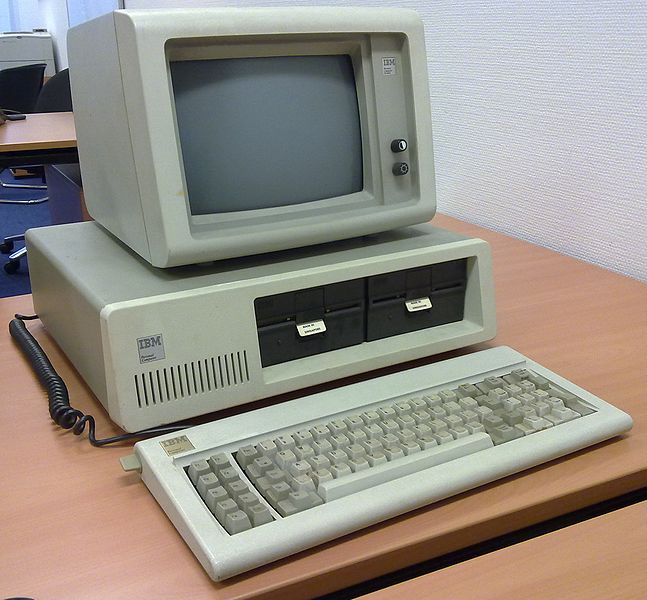IBM Personal Computer
The IBM Personal Computer, commonly known as the IBM PC, is the original version and progenitor of the IBM PC compatible hardware platform. It is IBM model number 5150, and was introduced on August 12, 1981. It was created by a team of engineers and designers under the direction of Don Estridge of the IBM Entry Systems Division in Boca Raton, Florida.
Alongside "microcomputer" and "home computer", the term "personal computer" was already in use before 1981. It was used as early as 1972 to characterize Xerox PARC's Alto. However, because of the success of the IBM Personal Computer, the term PC came to mean more specifically a microcomputer compatible with IBM's PC products.
If you LIKE this hit LIKE
IBM Personal Computer
Origins [edit]
International Business Machines (IBM) was in 1981 one of the world's largest companies, and dominated the computer industry. Perhaps distracted by a long-running antitrust lawsuit, however, it completely missed the fast-growing minicomputer market during the 1970s. It wished to avoid the same outcome with the new personal computer market,[1] dominated by the Commodore PET, Atari 8-bit family, Apple II, Tandy Corporation's TRS-80s, and various CP/M machines.[2]
Desktop sized programmable calculators by Hewlett Packard had evolved into the HP 9830 BASIC language computer by 1972. In 1973 the IBM Los Gatos Scientific Center developed a portable computer prototype called SCAMP (Special Computer APL Machine Portable) based on the IBM PALM processor with a Philips compact cassette drive, small CRT and full function keyboard. SCAMP emulated an IBM 1130 minicomputer in order to run APL\1130.[3] In 1973 APL was generally available only on mainframe computers, and most desktop sized microcomputers such as the Wang 2200 or HP 9800 offered only BASIC. Because SCAMP was the first to emulate APL\1130 performance on a portable, single user computer, PC Magazine in 1983 designated SCAMP a "revolutionary concept" and "the world's first personal computer".[3][4] This seminal, single use portable computer now resides in the Smithsonian Institution, Washington, DC.
Successful demonstrations of the 1973 SCAMP prototype led to the IBM 5100 portable microcomputer launched in 1975. In the late 1960s such a machine would have been nearly as large as two desks and would have weighed about half a ton.[3] The IBM 5100 was a complete computer system programmable in BASIC or APL, with a small built-in CRT monitor, keyboard, and tape drive for data storage. It was also very expensive — up to $20,000 USD. It was specifically designed for professional and scientific problem-solvers, not business users or hobbyists.[5] When the PC was introduced in 1981, it was designated as the IBM 5150, putting it in the "5100" series, though its architecture was not directly descended from the IBM 5100. Later models followed in the trend: for example, thePC/XT, IBM Portable Personal Computer, and PC AT are IBM machine types 5160, 5155, and 5170, respectively.[6]
New products at IBM typically required about four years for development. The company recognized that to compete with other personal computers it needed to develop its offering much more quickly.[7] In summer 1980 IBM assigned Don Estridge the task of designing an IBM personal computer.[1] Rather than going through the usual IBM design process, a special team was assembled with authorization to bypass normal company restrictions and get something to market rapidly. This project was given the code name Project Chess at the IBM Entry Systems Division in Boca Raton, Florida. The team consisted of twelve people directed by Estridge, with Chief Designer Lewis Eggebrecht.[8]
The IBM team developed the PC in about a year.[1] Estridge's team considered using the IBM 801 processor (an early RISC CPU) and its operating system that had been developed at the Thomas J. Watson Research Center in Yorktown Heights, New York. The 801 processor was more than an order of magnitude more powerful than the Intel 8088, and the operating system more advanced than the DOS 1.0 operating system from Microsoft, which was finally selected. Ruling out an in-house solution made the team’s job much easier and may have avoided a delay in the schedule, but the ultimate consequences of this decision for IBM were far-reaching. IBM had recently developed the Datamaster business microcomputer, which used an Intel processor and peripheral ICs; familiarity with these chips and the availability of the Intel 8088 processor was a deciding factor in the choice of processor for the new product. Even the 62-pin expansion bus slots were designed to be similar to the Datamaster slots. Delays due to in-house development of the Datamaster software also influenced the design team to a fast-track development process for the PC, with publicly available technical information to encourage third-party developers.[9]
Instead of proprietary components, the team decided to build the machine with "off-the-shelf" parts from a variety of different original equipment manufacturers (OEMs) and countries. Previously IBM had always developed its own components.[1] Secondly for scheduling and cost reasons, rather than developing unique IBM PC monitor and printer designs, project management decided to utilize an existing "off-the-shelf" IBM monitor developed earlier in IBM Japan as well as an existing Epson printer model. Consequently, the unique IBM PC industrial design elements were relegated to the system unit and keyboard.[10] They also decided on an open architecture, so that other manufacturers could produce and sell peripheral components and compatible software without purchasing licenses. IBM also sold anIBM PC Technical Reference Manual that included complete and fully accurate circuit schematics, a listing of the ROM BIOS source code, and other engineering and programming information.[11] Because IBM's design used off-the-shelf parts, the IBM copyright only appeared in the ROM BIOS and on the company logo.[1]
IBM introduced the PC on August 12, 1981. Six weeks later at COMDEX Fall, Tecmar had 20 PC products available for sale. These products included memory expansion, IEEE-488, data acquisition, and PC Expansion chassis[12][13][14][15] .[16] Pricing for the IBM PC started at $1,565 for a bare-bones configuration without disk drives.[17] Another way the PC differed from previous IBM projects was its sales and marketing. The company used Charlie Chaplin's The Little Tramp character as its mascot in a series of popular advertisements. In addition to its existing corporate sales force, IBM opened its own stores and also sold the PC throughComputerLand and other resellers.[1]
Other manufacturers soon reverse engineered the BIOS to produce their own non-infringing functional copies. Columbia Data Productsintroduced the first IBM-PC compatible computer in June 1982. In November 1982, Compaq Computer Corporation announced theCompaq Portable, the first portable IBM PC compatible. The first models were shipped in March 1983.
IBM PC as standard [edit]
Main article: Influence of the IBM PC on the personal computer market
The success of the IBM computer led other companies to develop IBM Compatibles, which in turn led to branding like diskettes being advertised as "IBM format". An IBM PC clone could be built with off-the-shelf parts, but the BIOS required some reverse-engineering. Companies like Phoenix Software Associates, American Megatrends, Award, and others achieved workable versions of the BIOS, allowing companies like DELL, Compaq, and HP to manufacture PCs that worked like IBM's product. The IBM PC became the industry standard.
Third-party distribution [edit]
ComputerLand and Sears Roebuck partnered with IBM from the beginning of development. IBM's head of sales and marketing, H.L. ('Sparky') Sparks, relied on these retail partners for important knowledge of the marketplace. Computerland and Sears became the main outlets for the new product. More than 190 Computerland stores already existed, while Sears was in the process of creating a handful of in-store computer centers for sale of the new product. This guaranteed IBM widespread distribution across the U.S.
Targeting the new PC at the home market, Sears Roebuck sales failed to live up to expectations. This unfavorable outcome revealed that the strategy of targeting the office market was the key to higher sales.
If you LIKE this hit LIKE
Pages
Powered by Blogger.
About Me
- Medicine
- We trying to help people with information about medicine and diets
Blogger news
Blogroll
Blogger templates
Popular Posts
-
The IBM Personal Computer, commonly known as the IBM PC, is the original version and progenitor of the IBM PC compatible hardware platform. ...


